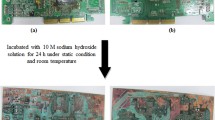Abstract
Waste PCBs (WPCBs) contain many types of valuable but environmentally harmful metals. Thus, the recovery of metals from WPCBs has a high environmental consequence and is essential for resource conservation. The study aims to develop eco-friendly methods for the recovery of metals from WPCBs. Through this work, a systematic procedure for the separation of components and extraction of metals is demonstrated. PCB was disintegrated by sequentially dissolving the solder in methane sulfonic acid (MSA), epoxy in sodium hydroxide, N-Methyl-2-Pyrrolidone (NMP), and metal interconnects dissolved separately in citric acid, hydrochloric acid, and sulphuric acid. Various processing conditions were evaluated to enhance the extraction. ICP-AES analysis was done for all leaching solutions, and it was observed that the solution of 3.5 M MSA and 0.5 M H2O2 completely dissolves the solder (Sn and Pb) in 1.5 h at 28ºC. Both citric acid and HCl have shown more than 75% recovery of copper and metals like Ag, Al, Pb, Ni, and Fe in the leaching solution in 4 h and 24 h, respectively, at 28ºC. Similarly, leaching using 15wt% H2SO4 aqueous solution with 10 ml of H2O2 has shown more than 95% extraction of Ag, Al. Fe and Ni in the leachate. Citric acid has shown very competitive results among all three leachates with low extraction time. It was concluded that citric acid could be used as an eco-friendly replacement for inorganic acids. Subsequently, recovery of copper using iron powder was performed, and 95% recovery was achieved using 4 g of iron powder, which was deduced using ICP-AES analysis. The work demonstrates the feasibility of sequential delamination and removal of layers in a PCB without prior pulverization. A sustainable process for extracting copper and potentially other metallic components in PCB, in durations much shorter than those reported, is demonstrated. Notably, citric acid resulted in over 83% recovery of copper in less than 4 h, comparable and possibly better than some other inorganic acids. Additionally, there is no need for pre-crushing, and the non-metallic and polymeric components are obtained intact, which may potentially be used for different applications.








Similar content being viewed by others
References
Abd El-Ghaffar MA, Abdel-Wahab ZH, Elwakeel KZ (2009) Extraction and separation studies of silver(I) and copper(II) from their aqueous solution using chemically modified melamine resins. Hydrometallurgy 96:27–34
Adhapure NN et al (2014) Use of large pieces of printed circuit boards for bioleaching to avoid “precipitate contamination problem” and to simplify overall metal recovery. MethodsX 1:181–186
Behnamfard A, Salarirad MM, Veglio F (2013) Process development for recovery of copper and precious metals from waste printed circuit boards with emphasis on palladium and gold leaching and precipitation. Waste Manag 33:2354–2363
Chakraborty P, Selvaraj S, Nakamura M, Prithiviraj B, Cincinelli A, Bang JJ (2018) PCBs and PCDD/Fs in soil from informal e-waste recycling sites and open dumpsites in India: Levels, congener profiles and health risk assessment. Sci Total Environ 621:930–938
Chander M (2017) A study on the status and management of E-waste in India. Ph.D. thesis, Civil Engineering Department, Delhi Technological University, Delhi.
Elwakeel KZ, El-Sayed GO, Darweesh RS (2013) Fast and selective removal of silver(I) from aqueous media by modified chitosan resins. Int J Miner Process 120:26–34
Gopikaramanan R, Chandrakumar P, SenthilKumaran B (2017) Environmental free recovery of metals from printed circuit boards (PCBs) of waste electrical and electronic equipments (WEEE). Int J Mech Eng Technol 8(8):678–684
Jadhav U, Hocheng H (2015) Hydrometallurgical recovery of metals from large printed circuit board pieces. Sci Rep 5:14574. https://doi.org/10.1038/srep14574
Jadhav U, Su C, Hocheng H (2016) Leaching of metals from large pieces of printed circuit boards using citric acid and hydrogen peroxide. Environ Sci Pollut Res
Kyere VN, Greve K, Atiemo SM, Amoako D, Aboh IJK, Cheabu BS (2018) Contamination and health risk assessment of exposure to heavy metals in soils from informal e-waste recycling site in Ghana. Emerg Sci J 2(6)
Naima Habbache N, Alane SD, Tifouti L (2009) Leaching of copper oxide with different acid solutions. Chem Eng J 152:503–508
Ning C, Lin CSK, McKay DCWHG (2017) Waste Printed circuit board (PCB) recycling techniques. Top Curr Chem (z) 375:43
Stefanowicz T et al (1997) Copper recovery by the cementation method. Hydrometallurgy 47:69–90
Yee S, Jin H, Lam LKC (1988) Miniature liquid junction reference electrode with micromachined silicon cavity. Sens Actuat 15(4):337–345
Zhang X, Guan J, Guo Y, Cao Y, Guo J, Yuan H, Su R, Liang B, Gao G, Zhou Y, Xu J, Guo Z (2017) Effective dismantling of waste printed circuit board assembly with methanesulfonic acid containing hydrogen peroxide. Environ Prog Sustain Energy 36(3)
Acknowledgements
The authors would like to acknowledge their profound gratitude to Industrial Research and Consultancy Center, IIT Bombay, for giving this opportunity and all the financial support for this project. We are also thankful to the Sophisticated Analytical Instrument Facility (SAIF), IIT Bombay, and the Particulate Materials Lab, Department of Metallurgical Engineering and Materials Science, IIT Bombay.
Author information
Authors and Affiliations
Corresponding author
Ethics declarations
Conflict of interest
Safique Anwer, Ayushi Panghal, Ikhlaq Majid, and Sudhanshu Mallick declare no conflict of interest.
Additional information
Editorial responsibility: Anna Grobelak.
Rights and permissions
About this article
Cite this article
Anwer, S., Panghal, A., Majid, I. et al. Urban mining: recovery of metals from printed circuit boards. Int. J. Environ. Sci. Technol. 19, 9731–9740 (2022). https://doi.org/10.1007/s13762-021-03662-y
Received:
Revised:
Accepted:
Published:
Issue Date:
DOI: https://doi.org/10.1007/s13762-021-03662-y




